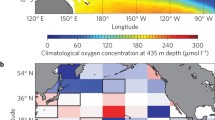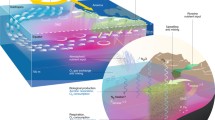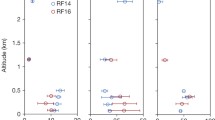Abstract
Simulations of oxidized nitrogen performed withglobal transport tracer models systematicallyunderestimate the concentrations of total nitrate atremote marine locations in the Mid-Pacific. Higheremission rates in the models of nitrogen oxides(\({\text{NO}}_x = {\text{NO + NO}}_{\text{2}} \)) from continental sources or alarger influx from the stratosphere do not seem tobe able to account for the shortfall. We are led toconclude that there has to be a substantial sourcelocated in oceanic areas. We speculate that\({\text{NO}}_x \)-emission from electrical discharges overthe oceans could be the source we are looking for.Airborne observations of atmospheric concentrationsof oxidized nitrogen and ozone in the remoteatmosphere and observations of nitrate wetdeposition in remote sites are used as additionalconstraints to check the plausibility of thishypothesis. We find that a larger emission of\({\text{NO}}_x \) due to lightning activity over the oceansindeed results in a much improved simulation oftotal nitrate in the remote Pacific, particularly inthe Equatorial and Tropical South Pacific and thatsuch a scenario is generally consistent withavailable observations of nitrate wet deposition andatmospheric concentrations of oxidized nitrogen andozone. An alternative hypothesis is that there is ahitherto unknown in situ source of \({\text{NO}}_x \) over thePacific Ocean.
Similar content being viewed by others
References
Ayers, G., Gillet, R., and Hara, H., 1995: Acidic Deposition in East Asia and Oceania, World Meteorological Organization, report in print.
Benkovitz, C., Scholtz, M., Pacyna, J., Tarrason, L., Dignon, J., Voldner, E., Spiro, P., Logan, J., and Graedel, T., 1996: Global gridded inventories of anthropogenic emissions of sulfur and nitrogen, J. Geophys. Res., in press.
Carroll, M., Hastie, D., Ridley, B., Rodgers, M., Torres, A., Davis, A., Bradshaw, J., Sandholm, S., Schiff, H., Karecki, D., Harriss, G., Mackay, G., Gregory, G., Condon, E., Trainer, M., Hubler, G., Montzka, D., Madronich, S., Albritton, D., Singh, H., Beck, S., Shipman, M., and Bachmeier, A., 1990: Aircraft measurements of NOx over the eastern Pacific and continental United States and implications for ozone production, J. Geophys. Res. 95 D7, 10205–10233.
Cooray, V., 1996: Energy dissipation in lightning flashes. Accepted for publication in J. Geophys. Res.
Crutzen, P., 1995: Ozone in the troposphere, in H. Singh (ed.), Composition, Chemistry, and Climate of the Atmosphere, Van Nostrand Reinold Pub., New York, pp. 349–393.
Crutzen, P. and Zimmermann, P., 1991: The changing photochemistry of the troposphere, Tellus 43AB, 136–151.
Dentener, F. and Crutzen, P., 1993: Reaction of N2O5 on tropospheric aerosols: Impact on the global distributions of NOx, O3 and OH, J. Geophys. Res. 98, 7149–7163.
Dentener, F., Hein, R., and Roelofs, G., 1995: A comparison of background ozone concentrations calculated by the three models ECHAM, MOGUNTIA and TM2 with measurements, Report cm-88, International Meteorological Institute in Stockholm, Department of Meteorology, Stockholm University.
Dentener, F., Carmichel, G., Zhang, Y., Lelieveld, J., and Crutzen, P., 1996: The role of mineral aerosol as a reactive surface in the global troposphere, J. Geophys. Res., in press.
Drummond, J., Ehhalt, D., and Volz, A., 1988: Measurements of nitric oxide between 0–12 km altitude and 67° N to 60° S latitude obtained during STRATOZ III, J. Geophys. Res. 93 D12, 15831–15849.
Feichter, J. and Crutzen, P., 1990: Parameterization of vertical tracer transport due to cumulus convection in a global transport model and its evaluation with 222Radon measurements, Tellus 42B, 100–117.
Gallardo, L. and Rodhe, H., 1995: Evaluation of a global 3-D model of tropospheric oxidized nitrogen, Report cm-85, International Meteorological Institute in Stockholm, Department of Meteorology, Stockholm University.
Gallardo, L., Kjellström, E., and Feichter, J., 1995: Representation of the global emission of oxidized nitrogen by lightning discharges in large-scale models, Report cm-87, International Meteorological Institute in Stockholm, Department of Meteorology, Stockholm University.
Gallardo and Cooray, 1996: Could cloud-to-cloud discharges be as effective as cloud-to-ground discharges in producing NOx? Tellus B 48, 641–651.
Ganzeveld, L. and Lelieveld, J., 1995: Dry deposition parameterization in a chemistry general circulation model and its influence on the distribution of reactive gases, J. Geophys. Res. 100, 20999–21012.
Gille, J., Bailey, P., and Craig, C., 1987: Proposed reference model for nitric acid, Adv. Space Res. 7, 25–35.
Goldembaum G. and Dickerson R., 1993: Nitric oxide production by lightning discharges, J. Geophys. Res. 98, 18333–18338.
Granat, L., Suksomsankh, Simachaya, S., Tabucanon, M., and Rodhe, H., 1995: Regional background acidity and chemical composition of precipitation in Thailand, Atmos. Environ. 30, 1589–1596.
Holton, J., 1990: On the global exchange of mass between the stratosphere and troposphere, J. Atmos. Sci. 47, 392–395.
Holton, J., Haynes, P., McIntyre, M., Douglas, A., Rood, R., and Pfister, L., 1996: Stratospheretroposphere exchange, Rev. Geophys., in press.
Hubler, G., Fahey, D., Ridley, B., Gregory, G., and Fehsenfeld, F., 1992: Airborne measurements of total reactive odd nitrogen (NOy), J. Geophys. Res. 97, 9833–9850.
IPCC, 1992: Climate Change: The IPCC Supplementary Report, Cambridge University Press, Cambridge, U.K.
Isaksen, I. and Rodhe, H., 1978: A two-dimensional model for the global distribution of gases and aerosol particles in the troposphere, Report AC-47, International Meteorological Institute, University of Stockholm.
Kanakidou, M., Singh H., Valentin, K., and Crutzen, P., 1991: A two-dimensional study of ethane and propane oxidation in the troposphere, J. Geophys. Res. 96, 15395–15413.
Kanakidou, M., Crutzen, P., Zimmermann, P., and Bonsang, B., 1992: A 3-D global study of the photochemistry of ethane and propane in the troposphere: production and transport of organic nitrogen compounds, in H. van Dop and G. Kallos (eds.), Air Pollution Modeling and Its Application {vnIX}, Plenum Press, New York.
Kasibhatla, P., Levy, H., Moxim, W., and Chameides, W., 1991: The relative impact of stratospheric photochemical production on tropospheric NOy levels: A model study, J. Geophys. Res. 96, 18631–18646.
Kasibhatla, P., Levy, H., and Moxim, W., 1993: Global NOx, HNO3, PAN and NOy distributions from fossil fuel combustion emissions: A model study, J. Geophys. Res. 98, 7165–7180.
Komhyr, W., Oltmans, S., Franchois, P., Evans, W., and Mathews, W., 1989: The latitudinal distribution of ozone to 35 km altitude from ECC ozone sonde observations, 1985–1987, in R. Bojkov and P. Fabian (eds.), Ozone in the Atmosphere, A. Deepak Publishing, Hampton, Virginia, pp. 147–150.
Kotaki, M. and Katoh, C., 1983: The global distribution of thunderstorm activity observed by the Ionosphere Sounding Satellite (ISS-b), J. Atmos. Terr. Phys. 45, 833–847.
Kowalczyk, M. and Bauer, E., 1982: Lightning as a source of NO in the troposphere, Rep. FAA-EE-824. U.S. Dept. of Transp., Washington, D.C.
Langner, J. and Rodhe, H., 1991: A global three-dimensional model of the tropospheric sulfur cycle, J. Atmos. Chem. 13, 225–265.
Mackerras, D. and Darveniza, M., 1994: Latitudinal variation of lightning occurrence characteristics, J. Geophys. Res. 99, 10813–10821.
Molinié, J. and Pontakis, C., 1995: A climatological study of tropical thunderstorm clouds and lightning frequencies on the French Guyana coast, Geophys. Res. Lett. 22, 1085–1088.
Murphy, D., Fahey, D., Proffitt, M., Liu, S., Chan, K., Eubank, C., Kawa, S., and Kelly, K., 1993: Reactive nitrogen and its correlation with ozone in the lower stratosphere and upper troposphere, J. Geophys. Res. 98, 8751–8773.
Orville, R. and Henderson, R., 1986: Global distribution of midnight lightning: September 1977 to August 1978, Mon. Weather. Rev. 114, 2460–2653.
Penner, J., Atherton, C., Dignon, J., Ghan, S., and Walton, J., 1991: Tropospheric nitrogen: A three dimensional study of sources, distributions and deposition, J. Geophys. Res. 96, 959–990.
Petersen, W., Rutledge, S., and Orville, R., 1996: Cloud-to-ground lightning observations from TOGA COARE: Selected results and lightning location algorithms, Mon. Wea. Rev. 124, 602–620.
Price, C. and Rind, D., 1992: A simple lightning parameterization for calculating global lightning distributions, J. Geophys. Res. 97, 9919–9933.
Prospero, J. and Savoie, D., 1989: Effect of continental sources on nitrate concentrations over the Pacific ocean, Nature 339, 687–689.
Ridley, B., Walega, J., Dye, J., and Grahek, F., 1994: Distribution of NO, NOx, NOy and O3 to 12 km altitude during the summer monsoon season over New Mexico, J. Geophys. Res. 99, 25519–25534.
Roeckner, E., Arpe, K., Bengtsson, L., Brinkop, S., Dümenil, L., Esch, M., Kirk, E., Lunkeit, M., Ponater, B., Rockel, B., Sausen, R., Schelse, U., Schubert, S., and Windelband, M., 1992: Simulation of the present-day climate with the ECHAM model: Impact of model physics and resolution, Rep., No. 93, Max-Planck-Institute for Meteorology, Hamburg, Germany.
Sanhueza, E., Elbert, W., Rondón, A., Arias, M. C., and Hermoso, M., 1989: Organic and inorganic acids in rain from a remote site of the Venezuelan savannah, Tellus 41B, 170–176.
Savoie, D., Prospero, J., Saltzman, E., 1989a: Nitrate, non-seasalt sulfate and methanesulfonate over the Pacific Ocean, in Chemical Oceanography 10, 219–250.
Singh, B., Herlth, D., Kolyer, R., Salas, L., Bradshaw, J., Sandholm, S., Davis, D., Crawford, J., Kondo, Y., Koike, M., Talbot, R., Gregory, G., Sachse, G., Browell, E., Blake, R., Rowland, F., Newell, R., Merrill, J., Heikes, B., Liu, S., Crutzen, P., Kanakidou, M., 1996: Reactive nitrogen and ozone over the western Pacific: Distribution, partitioning and sources, J. Geophys. Res. 101, 1793–1808.
Turman, B. and Edgar, B., 1982: Global lightning distribution at dawn and dusk, J. Geophys. Res. 87, 1191–1206.
Valentin, K., 1991: Numerical modeling of climatic and anthropogenic influences on global atmospheric chemistry since the last glacial maximum, Ph.D. Thesis, University of Mainz, Germany, 238 pp.
Warneck, P., 1988: In Dmowska and Holton (eds.), Chemistry of the Natural Atmosphere, Int. Geophys. Ser. 41, Academic Press, New York.
Zimmermann, P., 1988: MOGUNTIA: A handy global tracer model, in van Dop (ed.), Air Pollution Modeling and Its Applications VI, Plenum, New York.
Author information
Authors and Affiliations
Rights and permissions
About this article
Cite this article
GALLARDO, L., RODHE, H. Oxidized Nitrogen in the Remote Pacific: The Role of Electrical Discharges over the Oceans. Journal of Atmospheric Chemistry 26, 147–168 (1997). https://doi.org/10.1023/A:1005738402496
Issue Date:
DOI: https://doi.org/10.1023/A:1005738402496




